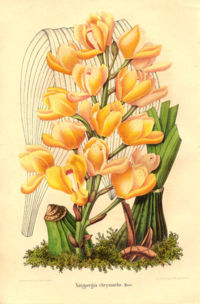Acineta
| Orchid genus Acineta {{{status}}} Fossil range: {{{fossil_range}}}
| ||||||||||||||||||||||||||||||||||||||||||||||||||||||||||||||||||
|---|---|---|---|---|---|---|---|---|---|---|---|---|---|---|---|---|---|---|---|---|---|---|---|---|---|---|---|---|---|---|---|---|---|---|---|---|---|---|---|---|---|---|---|---|---|---|---|---|---|---|---|---|---|---|---|---|---|---|---|---|---|---|---|---|---|---|
 Acineta chrysantha | ||||||||||||||||||||||||||||||||||||||||||||||||||||||||||||||||||
| Plant Info | ||||||||||||||||||||||||||||||||||||||||||||||||||||||||||||||||||
| ||||||||||||||||||||||||||||||||||||||||||||||||||||||||||||||||||
| Scientific classification | ||||||||||||||||||||||||||||||||||||||||||||||||||||||||||||||||||
| ||||||||||||||||||||||||||||||||||||||||||||||||||||||||||||||||||
| [[{{{diversity_link}}}|Diversity]] | ||||||||||||||||||||||||||||||||||||||||||||||||||||||||||||||||||
| {{{diversity}}} | ||||||||||||||||||||||||||||||||||||||||||||||||||||||||||||||||||
| Binomial name | ||||||||||||||||||||||||||||||||||||||||||||||||||||||||||||||||||
| {{{binomial}}} | ||||||||||||||||||||||||||||||||||||||||||||||||||||||||||||||||||
| Trinomial name | ||||||||||||||||||||||||||||||||||||||||||||||||||||||||||||||||||
| {{{trinomial}}} | ||||||||||||||||||||||||||||||||||||||||||||||||||||||||||||||||||
| Type Species | ||||||||||||||||||||||||||||||||||||||||||||||||||||||||||||||||||
| {{{type_species}}} | ||||||||||||||||||||||||||||||||||||||||||||||||||||||||||||||||||
| Species | ||||||||||||||||||||||||||||||||||||||||||||||||||||||||||||||||||
| [[Image:{{{range_map}}}|{{{range_map_width}}}|]] | ||||||||||||||||||||||||||||||||||||||||||||||||||||||||||||||||||
| Synonyms | ||||||||||||||||||||||||||||||||||||||||||||||||||||||||||||||||||
| {{{synonyms}}} |
Acineta Lindley, 1843 is a small genus belonging to the orchid family (Orchidaceae). The name is derived from the Greek word 'akinetos' (immobile), referring to the rigid labellum (lip).
These epiphytic orchids occur in tropical mountainous forests from Mexico to western South America, at altitudes up to 2,000 m. They are sometimes lithophytic when found on steep embankments.
The large, plicate leaves are parallel-nerved and resemble those of Peristeria and Lycaste, while the structure of the flowers bears a closer resemblance to Stanhopea.
The species produce a pendent inflorescence, bearing racemes of many fragrant cup-shaped, pale yellow to reddish brown flowers. The sidelobes of the labellum (lip) come together in a central callus. The basal part of the lip (hypochile) is at least as long as the sidelobes. The column is pubescent. The column of these orchids bears two pollinia, except in Acineta dalessandroi, which has four (making its classification in this genus doubtful). These orchids are insect pollinated by male bees in the genus Eulaema or Eufriesia.
Some regard these as being among of the most splendid looking of all orchids.
For relatives of Acineta see Stanhopeinae.
Species
- Acineta alticola C.Schweinf. (1951)(Venezuela).
- Acineta antioquiae Schltr. (1917) (Colombia).
- Acineta barkeri (Bateman) Lindl. (1843) (Mexico to Guatemala). (fragrant)
- Acineta beyrodtiana Schltr. (1917) (Colombia). (fragrant)
- Acineta chrysantha (C.Morren) Lindl. (1850) (SE. Mexico to C. America). (fragrant)
- Acineta confusa Schltr. (1917) (C. America).
- Acineta cryptodonta Rchb.f. (1854)(C. America).
- Acineta dalessandroi Dodson (1984) (S. Ecuador).
- Acineta densa Lindl. (1851)(C. America).
- Acineta erythroxantha Rchb.f. (1854) (Colombia to NW. Venezuela). (fragrant)
- Acineta hagsateri Salazar & Soto Arenas (2002, publ. 2003)(Mexico)
- Acineta hennisiana Schltr. (1917) (Colombia).
- Acineta hrubyana Rchb.f. (1882) (Colombia).
- Acineta mireyae G.Gerlach & M.H.Weber (2003) (Panama)
- Acineta salazarii Soto Arenas (2003) (mexico to El Salvador)
- Acineta sella-turcica Rchb.f (1852) (C. America).
- Acineta sulcata Rchb.f. (1879) (Ecuador (?).
- Acineta superba (Kunth) Rchb.f. in W.G.Walpers (1863)(Panama to Suriname and Ecuador). (type species) (fragrant)
Intergeneric Hybrids
Reference
Günter Gerlach 2001. "Die Subtribus Stanhopeinae: 3. Horichia bis Lacaena," in: J. Orchideenfreund 8(2): 105-118 (2001) - col. illus.